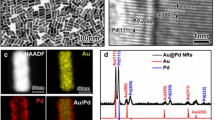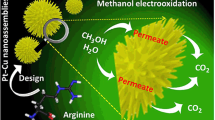Abstract
Anisotropic Pd nanoparticles with highly branched morphologies are urgently needed as building blocks for nanoscale devices, catalysts, and sensing materials owing to their novel structures and unique physicochemical properties. However, realizing size control and branch manipulation for these materials is very challenging. In this study, we develop a facile ultrafine Cu seed-mediated approach in the aqueous phase to produce novel Pd–Cu trigonal hierarchical nanoframes (THNFs). The main branch of most of the obtained nanocrystals is tripod-like, with advanced branches along the arms as frame units having self-similarity. In this method, the size of the Pd–Cu THNFs can be flexibly controlled by manipulating the nucleation involving the sub-3 nm Cu seeds. These Pd–Cu THNFs outperform Pd black with regard to their ethanol-oxidation performance, having a specific activity and mass activity 9.7 and 6.6 times higher, respectively. This research provides a versatile ultrafine seed-mediated approach for producing size-controlled anisotropic bimetallic nanoframes.

Similar content being viewed by others
References
Nishihata, Y.; Mizuki, J.; Akao, T.; Tanaka, H.; Uenishi, M.; Kimura, M.; Okamoto, T.; Hamada, N. Self-regeneration of a Pd-perovskite catalyst for automotive emissions control. Nature 2002, 418, 164–167.
Blaser, H. U.; Indolese, A.; Schnyder, A.; Steiner, H.; Studer, M. Supported palladium catalysts for fine chemicals synthesis. J. Mol. Catal. A: Chem. 2001, 173, 3–18.
Fang, P. P.; Jutand, A.; Tian, Z. Q.; Amatore, C. Au-Pd core–shell nanoparticles catalyze Suzuki–Miyaura reactions in water through Pd leaching. Angew. Chem., Int. Ed. 2011, 50, 12184–12188.
Reimann, S.; Stötzel, J.; Frahm, R.; Kleist, W.; Grunwaldt, J. D.; Baiker, A. Identification of the active species generated from supported Pd catalysts in heck reactions: An in situ quick scanning EXAFS investigation. J. Am. Chem. Soc. 2011, 133, 3921–3930.
Calò, V.; Nacci, A.; Monopoli, A.; Montingelli, F. Pd nanoparticles as efficient catalysts for Suzuki and Stille coupling reactions of aryl halides in ionic liquids. J. Org. Chem. 2005, 70, 6040–6044.
Xu, C. W.; Wang, H.; Shen, P. K.; Jiang, S. P. Highly ordered Pd nanowire arrays as effective electrocatalysts for ethanol oxidation in direct alcohol fuel cells. Adv. Mater. 2007, 19, 4256–4259.
Guo, C. X.; Zhang, L. Y.; Miao, J. W.; Zhang, J. T.; Li, C. M. DNA-functionalized graphene to guide growth of highly active Pd nanocrystals as efficient electrocatalyst for direct formic acid fuel cells. Adv. Energy Mater. 2013, 3, 167–171.
Chen, L. Y.; Chen, N.; Hou, Y.; Wang, Z. C.; Lv, S. H.; Fujita, T.; Jiang, J. H.; Hirata, A.; Chen, M. W. Geometrically controlled nanoporous PdAu bimetallic catalysts with tunable Pd/Au ratio for direct ethanol fuel cells. ACS Catal. 2013, 3, 1220–1230.
Bianchini, C.; Shen, P. K. Palladium-based electrocatalysts for alcohol oxidation in half cells and in direct alcohol fuel cells. Chem. Rev. 2009, 109, 4183–4206.
Shao, M. H.; Sasaki, K.; Adzic, R. R. Pd-Fe nanoparticles as electrocatalysts for oxygen reduction. J. Am. Chem. Soc. 2006, 128, 3526–3527.
Kariuki, N. N.; Wang, X. P.; Mawdsley, J. R.; Ferrandon, M. S.; Niyogi, S. G.; Vaughey, J. T.; Myers, D. J. Colloidal synthesis and characterization of carbon-supported Pd-Cu nanoparticle oxygen reduction electrocatalysts. Chem. Mater. 2010, 22, 4144–4152.
Mazumder, V.; Chi, M. F.; Mankin, M. N.; Liu, Y.; Metin, Ö.; Sun, D. H.; More, K. L.; Sun, S. H. A facile synthesis of MPd (M = Co, Cu) nanoparticles and their catalysis for formic acid oxidation. Nano Lett. 2012, 12, 1102–1106.
Chang, J. F.; Feng, L. G.; Liu, C. P.; **ng, W.; Hu, X. L. An effective Pd–Ni2P/C anode catalyst for direct formic acid fuel cells. Angew. Chem., Int. Ed. 2014, 53, 122–126.
**, M. S.; Zhang, H.; **e, Z. X.; **a, Y. N. Palladium nanocrystals enclosed by {100} and {111} facets in controlled proportions and their catalytic activities for formic acid oxidation. Energy Environ. Sci. 2012, 5, 6352–6357.
Burda, C.; Chen, X. B.; Narayanan, R.; El-Sayed, M. A. Chemistry and properties of nanocrystals of different shapes. Chem. Rev. 2005, 105, 1025–1102.
Zhang, H.; **, M. S.; **a, Y. N. Noble-metal nanocrystals with concave surfaces: Synthesis and applications. Angew. Chem., Int. Ed. 2012, 51, 7656–7673.
Wang, Z. D.; Bharathi, M. S.; Hariharaputran, R.; **ng, H.; Tang, L. H.; Li, J. H.; Zhang, Y. W.; Lu, Y. PH-dependent evolution of five-star gold nanostructures: An experimental and computational study. ACS Nano 2013, 7, 2258–2265.
Chen, S.; Su, H. Y.; Wang, Y. C.; Wu, W. L.; Zeng, J. Size-controlled synthesis of platinum–copper hierarchical trigonal bipyramid nanoframes. Angew. Chem. 2015, 127, 110–115.
Lin, T. H.; Lin, C. W.; Liu, H. H.; Sheu, J. T.; Hung, W. H. Potential-controlled electrodeposition of gold dendrites in the presence of cysteine. Chem. Commun. 2011, 47, 2044–2046.
Chen, X.; Cui, C. H.; Guo, Z.; Liu, J. H.; Huang, X. J.; Yu, S. H. Unique heterogeneous silver-copper dendrites with a trace amount of uniformly distributed elemental Cu and their enhanced SERS properties. Small 2011, 7, 858–863.
Zhou, P.; Dai, Z. H.; Fang, M.; Huang, X. H.; Bao, J. C.; Gong, J. F. Novel dendritic palladium nanostructure and its application in biosensing. J. Phys. Chem. C 2007, 111, 12609–12616.
Watt, J.; Cheong, S.; Toney, M. F.; Ingham, B.; Cookson, J.; Bishop, P. T.; Tilley, R. D. Ultrafast growth of highly branched palladium nanostructures for catalysis. ACS Nano 2010, 4, 396–402.
Zhang, L.; Roling, L. T.; Wang, X.; Vara, M.; Chi, M. F.; Liu, J. Y.; Choi, S.-I.; Park, J.; Herron, J. A.; **e, Z. X. et al. Platinum-based nanocages with subnanometer-thick walls and well-defined, controllable facets. Science 2015, 349, 412–416.
Chen, C.; Kang, Y. J.; Huo, Z. Y.; Zhu, Z. W.; Huang, W. Y.; **n, H. L.; Snyder, J. D.; Li, D. G.; Herron, J. A.; Mavrikakis, M. et al. Highly crystalline multimetallic nanoframes with three-dimensional electrocatalytic surfaces. Science 2014, 343, 1339–1343.
Long, R.; Rao, Z. L.; Mao, K. K.; Li, Y.; Zhang, C.; Liu, Q. L.; Wang, C. M.; Li, Z. Y.; Wu, X. J.; **ong, Y. J. Efficient coupling of solar energy to catalytic hydrogenation by using well-designed palladium nanostructures. Angew. Chem., Int. Ed. 2015, 54, 2425–2430.
**e, W.; Schlücker, S. Hot electron-induced reduction of small molecules on photorecycling metal surfaces. Nat. Commun. 2015, 6, 7570.
Niu, W. X.; Zhang, W. Q.; Firdoz, S.; Lu, X. M. Controlled synthesis of palladium concave nanocubes with sub-10-nanometer edges and corners for tunable plasmonic property. Chem. Mater. 2014, 26, 2180–2186.
Jiang, Y. Q.; Su, J. Y.; Yang, Y.; Jia, Y. Y.; Chen, Q. L.; **e, Z. X.; Zheng, L. S. A facile surfactant-free synthesis of Rh flower-like nanostructures constructed from ultrathin nanosheets and their enhanced catalytic properties. Nano Res. 2016, 9, 849–856.
Ding, L.-X.; Wang, A.-L.; Ou, Y.-N.; Li, Q.; Guo, R.; Zhao, W.-X.; Tong, Y.-X.; Li, G.-R. Hierarchical Pd-Sn alloy nanosheet dendrites: An economical and highly active catalyst for ethanol electrooxidation. Sci. Rep. 2013, 3, 1181.
Saleem, F.; Xu, B.; Ni, B.; Liu, H. L.; Nosheen, F.; Li, H. Y.; Wang, X. Atomically thick Pt-Cu nanosheets: Self-assembled sandwich and nanoring-like structures. Adv. Mater. 2015, 27, 2013–2018.
**a, B. Y.; Ng, W. T.; Wu, H. B.; Wang, X.; Lou, X. W. Self-supported interconnected Pt nanoassemblies as highly stable electrocatalysts for low-temperature fuel cells. Angew. Chem., Int. Ed. 2012, 51, 7213–7216.
Tian, J. Q.; Liu, Q.; Cheng, N. Y.; Asiri, A. M.; Sun, X. P. Self-supported Cu3P nanowire arrays as an integrated high-performance three-dimensional cathode for generating hydrogen from water. Angew. Chem., Int. Ed. 2014, 53, 9577–9581.
Li, H.-H.; Cui, C.-H.; Zhao, S.; Yao, H.-B.; Gao, M.-R.; Fan, F.-J.; Yu, S.-H. Mixed-PtPd-shell PtPdCu nanoparticle nanotubes templated from copper nanowires as efficient and highly durable electrocatalysts. Adv. Energy Mater. 2012, 2, 1182–1187.
Gimeno, Y.; Creus, A. H.; González, S.; Salvarezza, R. C.; Arvia, A. J. Preparation of 100-160-nm-sized branched palladium islands with enhanced electrocatalytic properties on HOPG. Chem. Mater. 2001, 13, 1857–1864.
**ao, J. P.; **e, Y.; Tang, R.; Chen, M.; Tian, X. B. Novel ultrasonically assisted templated synthesis of palladium and silver dendritic nanostructures. Adv. Mater. 2001, 13, 1887–1891.
Zhu, X. H.; Li, A. D.; Wu, D.; Zhu, T.; Liu, Z. G.; Ming, N. B. High-resolution electron microscopy investigations on stacking faults in SrBi2Ta2O9 ferroelectric thin films. Appl. Phys. Lett. 2001, 78, 973–975.
Feldberg, S.; Klotz, P.; Newman, L. Computer evaluation of equilibrium constants from spectrophotometric data. Inorg. Chem. 1972, 11, 2860–2865.
Zhang, L.; Choi, S.-I.; Tao, J.; Peng, H.-C.; **e, S. F.; Zhu, Y. M.; **e, Z. X.; **a, Y. N. Pd–Cu bimetallic tripods: A mechanistic understanding of the synthesis and their enhanced electrocatalytic activity for formic acid oxidation. Adv. Funct. Mater. 2014, 24, 7520–7529.
Branicio, P. S.; Zhang, J. Y.; Srolovitz, D. J. Effect of strain on the stacking fault energy of copper: A first-principles study. Phys. Rev. B 2013, 88, 064104.
Wang, Y. W.; He, J. T.; Liu, C. C.; Chong, W. H.; Chen, H. Y. Thermodynamics versus kinetics in nanosynthesis. Angew. Chem., Int. Ed. 2015, 54, 2022–2051.
Maksimuk, S.; Teng, X. W.; Yang, H. Planar tripods of platinum: Formation and self-assembly. Phys. Chem. Chem. Phys. 2006, 8, 4660–4663.
Maksimuk, S.; Teng, X. W.; Yang, H. Roles of twin defects in the formation of platinum multipod nanocrystals. J. Phys. Chem. C 2007, 111, 14312–14319.
Kashchiev, D. Nucleation: Basic Theory with Applications; Butterworth Heinemann: Oxford,2000.
Wang, T.; LaMontagne, D.; Lynch, J.; Zhuang, J. Q.; Cao, Y. C. Colloidal superparticles from nanoparticle assembly. Chem. Soc. Rev. 2013, 42, 2804–2823.
Wang, Y.; Peng, H. C.; Liu, J. Y.; Huang, C. Z.; **a, Y. N. Use of reduction rate as a quantitative knob for controlling the twin structure and shape of palladium nanocrystals. Nano Lett. 2015, 15, 1445–1450.
**a, Y. N.; **a, X. H.; Peng, H.-C. Shape-controlled synthesis of colloidal metal nanocrystals: Thermodynamic versus kinetic products. J. Am. Chem. Soc. 2015, 137, 7947–7966.
Lai, S. C. S.; Kleijn, S. E. F.; Öztürk, F. T. Z.; van Rees Vellinga, V. C.; Koning, J.; Rodriguez, P.; Koper, M. T. M. Effects of electrolyte Ph and composition on the ethanol electro-oxidation reaction. Catal. Today 2010, 154, 92–104.
Mårtensson, N.; Nyholm, R.; Calén, H.; Hedman, J.; Johansson, B. Electron-spectroscopic studies of the Cu x Pd1-x alloy system: Chemical-shift effects and valence-electron spectra. Phys. Rev. B 1981, 24, 1725–1738.
Zhou, Z.-Y.; Wang, Q.; Lin, J.-L.; Tian, N.; Sun, S.-G. In situ FTIR spectroscopic studies of electrooxidation of ethanol on Pd electrode in alkaline media. Electrochim. Acta 2010, 55, 7995–7999.
Wang, A. L.; He, X. J.; Lu, X. F.; Xu, H.; Tong, Y. X.; Li, G. R. Palladium-cobalt nanotube arrays supported on carbon fiber cloth as high-performance flexible electrocatalysts for ethanol oxidation. Angew. Chem., Int. Ed. 2015, 54, 3669–3673.
Ahmed, M. S.; Jeon, S. Highly active graphene-supported NixPd100–x binary alloyed catalysts for electro-oxidation of ethanol in an alkaline media. ACS Catal. 2014, 4, 1830–1837.
Hong, W.; Wang, J.; Wang, E. K. Facile synthesis of highly active PdAu nanowire networks as self-supported electrocatalyst for ethanol electrooxidation. ACS Appl. Mater. Interfaces 2014, 6, 9481–9187.
Acknowledgements
We acknowledge financial support from the National Basic Research Program of China (Nos. 2014CB845605 and 2013CB933200), the National Natural Science Foundation of China (Nos. 21521061, 21573238, 21331006, 21571177, and 21520102001), Strtegic Priority Research Program of the Chinese Academy of Sciences (No. XDB20000000), the Natural Science Foundation of the Fujian Province (No. 2014J05022), and the Chunmiao Project of the Haixi Institute of the Chinese Academy of Sciences (No. CMZX-2014-004).
Author information
Authors and Affiliations
Corresponding author
Electronic supplementary material
12274_2017_1487_MOESM1_ESM.pdf
Facile ultrafine copper seed-mediated approach for fabricating quasi-two-dimensional palladium-copper bimetallic trigonal hierarchical nanoframes
Rights and permissions
About this article
Cite this article
Shen, M., Huang, Y., Wu, D. et al. Facile ultrafine copper seed-mediated approach for fabricating quasi-two-dimensional palladium-copper bimetallic trigonal hierarchical nanoframes. Nano Res. 10, 2810–2822 (2017). https://doi.org/10.1007/s12274-017-1487-5
Received:
Revised:
Accepted:
Published:
Issue Date:
DOI: https://doi.org/10.1007/s12274-017-1487-5




